The College’s academic cluster theme for 2024/2025 is ‘Perception’. The theme will be animated by a range of activities, including Queen’s College Symposia and work by resident creative artists.
In this exhibition the Library has selected a number of titles that might illuminate some aspects of how we perceive the world.
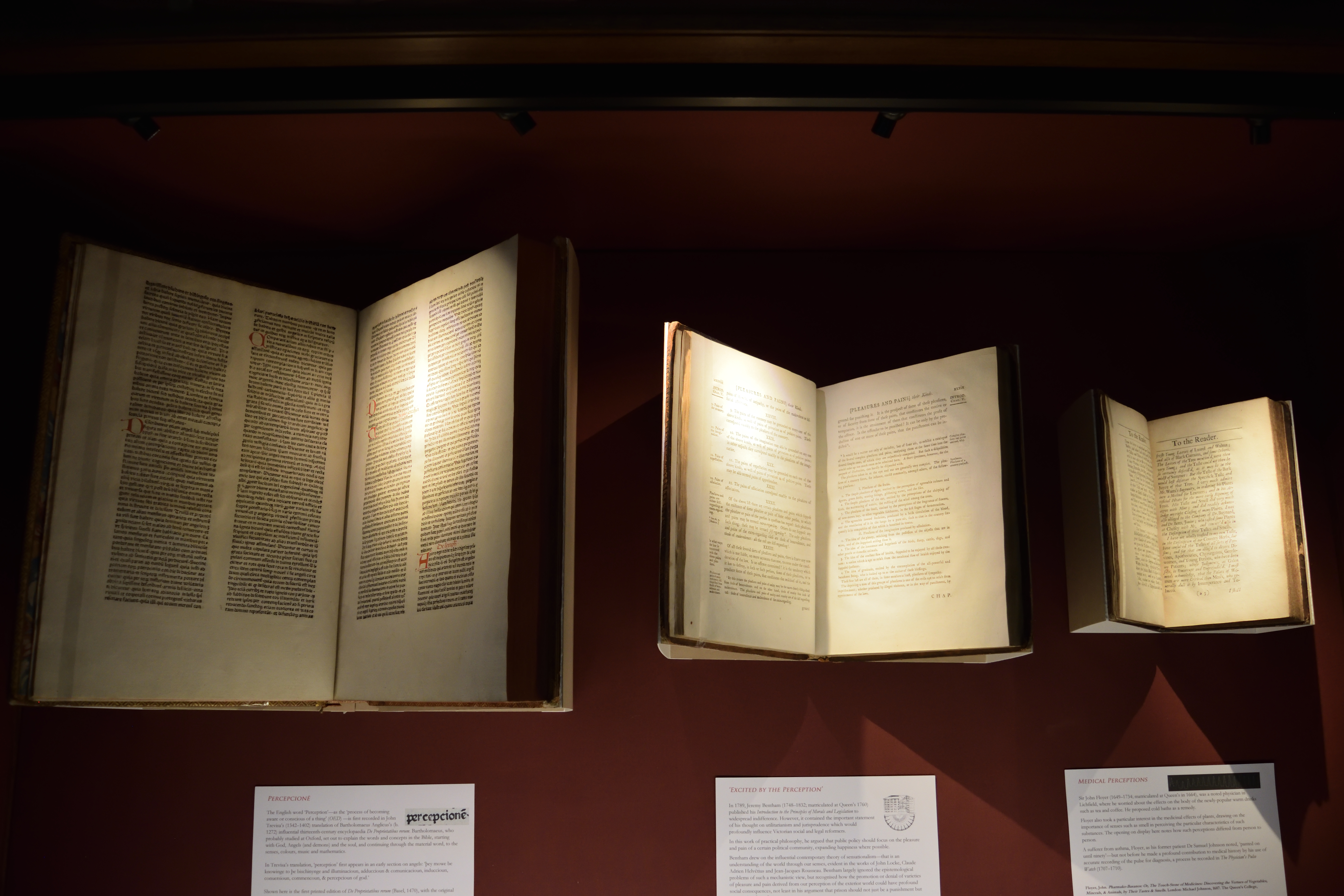
Bartholomaeus Anglicus, Incipit p[ro]hemiu[m] de p[ro]prietatibus re[rum]. [Basel], [Berthold Ruppel], 1470. The Queen’s College, Sel.a.202.
Bentham, Jeremy. An Introduction to the Principles of Morals and Legislation… London: T. Payne, 1789. The Queen’s College, FF.h.60.
Floyer, John. Pharmako-Basanos: Or, The Touch-Stone of Medicines: Discovering the Vertues of Vegetables, Minerals, & Animals, by Their Tastes & Smells. London: Michael Johnson, 1687. The Queen’s College, NN.s.3750/1.
Bartholomaeus Anglicus, Incipit p[ro]hemiu[m] de p[ro]prietatibus re[rum]. [Basel], [Berthold Ruppel], 1470. The Queen’s College, Sel.a.202.
Bentham, Jeremy. An Introduction to the Principles of Morals and Legislation… London: T. Payne, 1789. The Queen’s College, FF.h.60.
Floyer, John. Pharmako-Basanos: Or, The Touch-Stone of Medicines: Discovering the Vertues of Vegetables, Minerals, & Animals, by Their Tastes & Smells. London: Michael Johnson, 1687. The Queen’s College, NN.s.3750/1.
Percepcionē
Bartholomaeus Anglicus, Incipit p[ro]hemiu[m] de p[ro]prietatibus re[rum]. [Basel], [Berthold Ruppel], 1470. The Queen’s College, Sel.a.202.
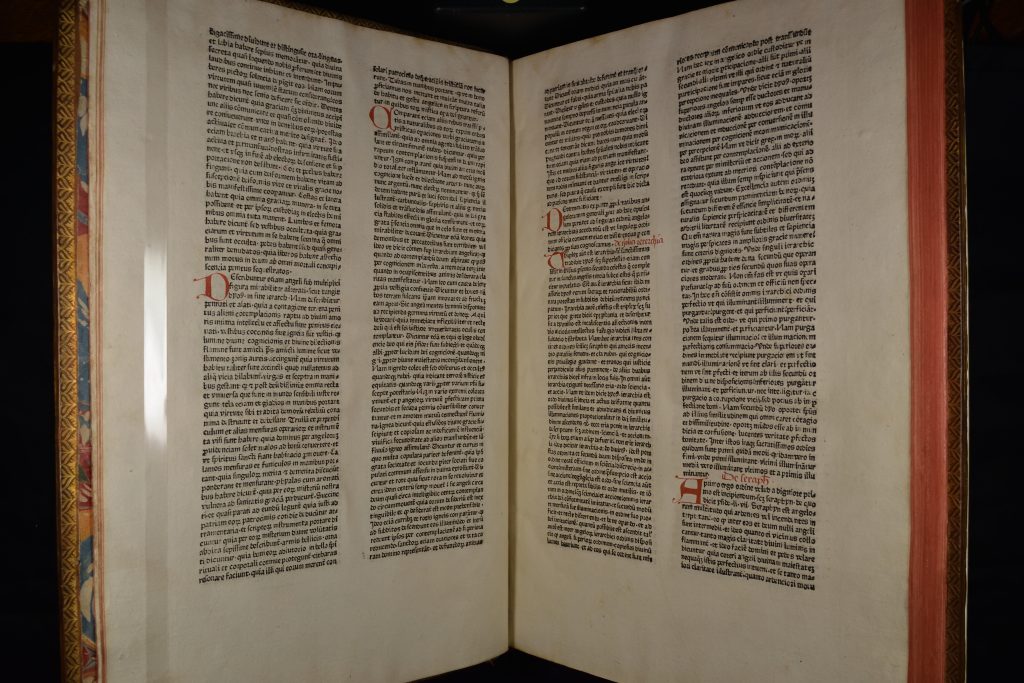
The English word ‘Perception’—as the ‘process of becoming aware or conscious of a thing’ (OED) —is first recorded in John Trevisa’s (1342–1402) translation of Bartholomaeus Anglicus’s (b. 1272) influential thirteenth-century encyclopaedia De Proprietatibus rerum. Bartholomaeus, who probably studied at Oxford, set out to explain the words and concepts in the Bible, starting with God, Angels (and demons) and the soul, and continuing through the material word, to the senses, colours, music and mathematics.
In Trevisa’s translation, ‘perception’ first appears in an early section on angels: ‘þey mowe be knowinge to þe bischinynge and illuminacioun, adduccioun & comunicacioun, induccioun, conuersioun, commencoun, & percepcioun of god.’
Shown here is the first printed edition of De Proprietatibus rerum (Basel, 1470), with the original Latin percepcionē.
‘Excited by the Perception’
Bentham, Jeremy. An Introduction to the Principles of Morals and Legislation… London: T. Payne, 1789. The Queen’s College, FF.h.60.
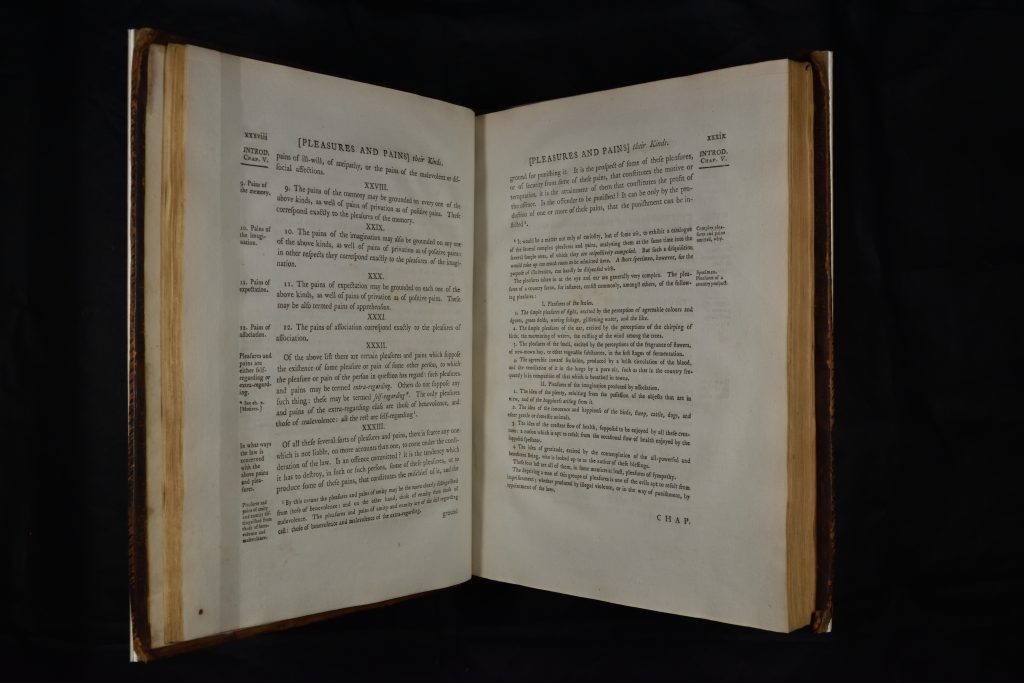
In 1789, Jeremy Bentham (1748–1832; matriculated at Queen’s 1760) published his Introduction to the Principles of Morals and Legislation to widespread indifference. However, it contained the important statement of his thought on utilitarianism and jurisprudence which would profoundly influence Victorian social and legal reformers.
In this work of practical philosophy, he argued that public policy should focus on the pleasure and pain of a certain political community, expanding happiness where possible.
Bentham drew on the influential contemporary theory of sensationalism—that is an understanding of the world through our senses, evident in the works of John Locke, Claude Adrien Helvétius and Jean-Jacques Rousseau. Bentham largely ignored the epistemological problems of such a mechanistic view, but recognised how the promotion or denial of varieties of pleasure and pain derived from our perception of the exterior world could have profound social consequences, not least in his argument that prison should not just be a punishment but an occasion for reform.
Medical Perceptions
Floyer, John. Pharmako-Basanos: Or, The Touch-Stone of Medicines: Discovering the Vertues of Vegetables, Minerals, & Animals, by Their Tastes & Smells. London: Michael Johnson, 1687. The Queen’s College, NN.s.3750/1.
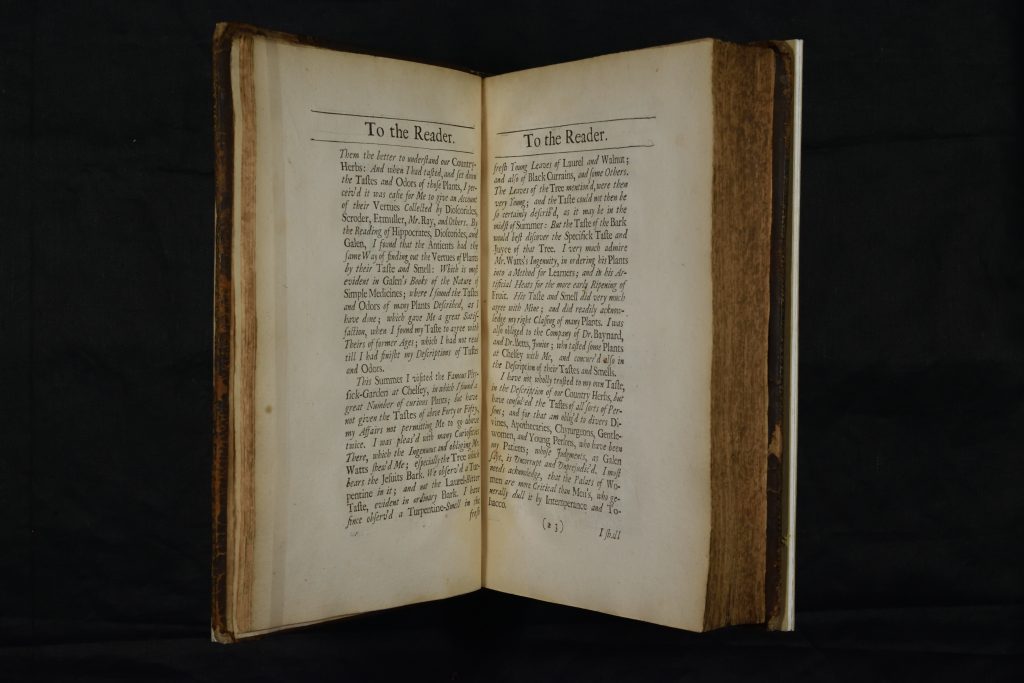
Sir John Floyer (1649–1734; matriculated at Queen’s in 1664), was a noted physician in Lichfield, where he worried about the effects on the body of the newly-popular warm drinks such as tea and coffee. He proposed cold baths as a remedy.
Floyer also took a particular interest in the medicinal effects of plants, drawing on the importance of senses such as smell in perceiving the particular characteristics of such substances. The opening on display here notes how such perceptions differed from person to person.
A sufferer from asthma, Floyer, as his former patient Dr Samuel Johnson noted, ‘panted on until ninety’—but not before he made a profound contribution to medical history by his use of accurate recording of the pulse for diagnosis, a process he recorded in The Physician’s Pulse Watch (1707–1710).
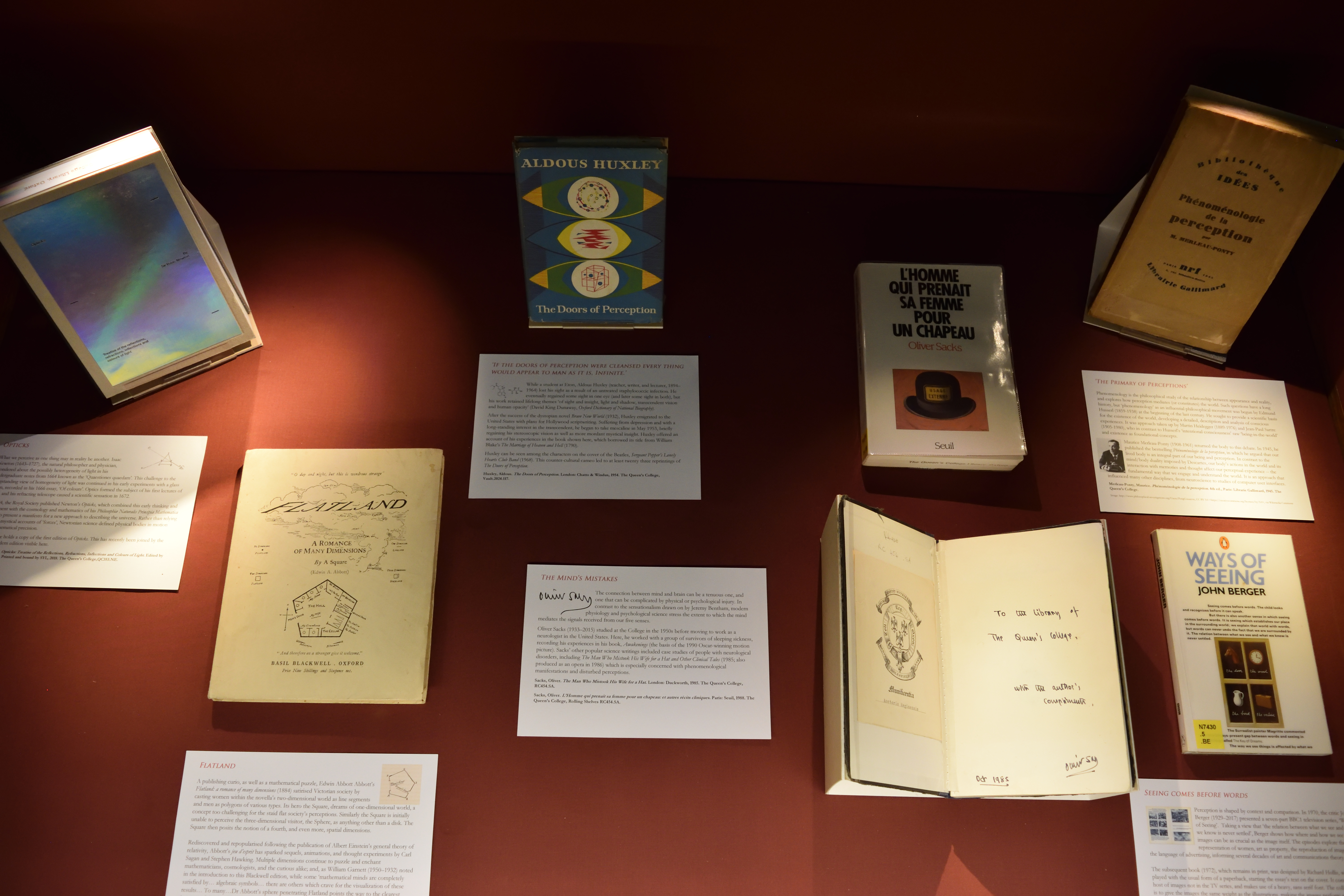
Newton, Isaac. Opticks: Treatise of the Reflections, Refractions, Inflections and Colours of Light. Edited by Laura Schröder, Printed and bound by SYL, 2018. The Queen’s College,QC353.NE.
Abbott, Edwin Abbott. Flatland: A Romance of Many Dimensions. 6th revised ed, Oxford: Basil Blackwell, 1950. The Queen’s College.
Huxley, Aldous. The Doors of Perception. London: Chatto & Windus, 1954. The Queen’s College, Vault.2024.117.
Sacks, Oliver. The Man Who Mistook His Wife for a Hat. London: Duckworth, 1985. The Queen’s College, RC454.SA.
Sacks, Oliver. L’Homme qui prenait sa femme pour un chapeau: et autres récits cliniques. Paris: Seuil, 1988. The Queen’s College, Rolling Shelves RC454.SA.
Merleau-Ponty, Maurice. Phénoménologie de la perception. 4th ed., Paris: Librarie Gallimard, 1945. The Queen’s College.
[A Book made by John Berger, et al]. Ways of Seeing: based on the BBC television series with John Berger. London: BBC Books & Penguin, 1972. The Queen’s College N7430.5.BE.
Newton, Isaac. Opticks: Treatise of the Reflections, Refractions, Inflections and Colours of Light. Edited by Laura Schröder, Printed and bound by SYL, 2018. The Queen’s College,QC353.NE.
Abbott, Edwin Abbott. Flatland: A Romance of Many Dimensions. 6th revised ed, Oxford: Basil Blackwell, 1950. The Queen’s College.
Huxley, Aldous. The Doors of Perception. London: Chatto & Windus, 1954. The Queen’s College, Vault.2024.117.
Sacks, Oliver. The Man Who Mistook His Wife for a Hat. London: Duckworth, 1985. The Queen’s College, RC454.SA.
Sacks, Oliver. L’Homme qui prenait sa femme pour un chapeau: et autres récits cliniques. Paris: Seuil, 1988. The Queen’s College, Rolling Shelves RC454.SA.
Merleau-Ponty, Maurice. Phénoménologie de la perception. 4th ed., Paris: Librarie Gallimard, 1945. The Queen’s College.
[A Book made by John Berger, et al]. Ways of Seeing: based on the BBC television series with John Berger. London: BBC Books & Penguin, 1972. The Queen’s College N7430.5.BE.
Opticks
Newton, Isaac. Opticks: Treatise of the Reflections, Refractions, Inflections and Colours of Light. Edited by Laura Schröder, Printed and bound by SYL, 2018. The Queen’s College,QC353.NE.
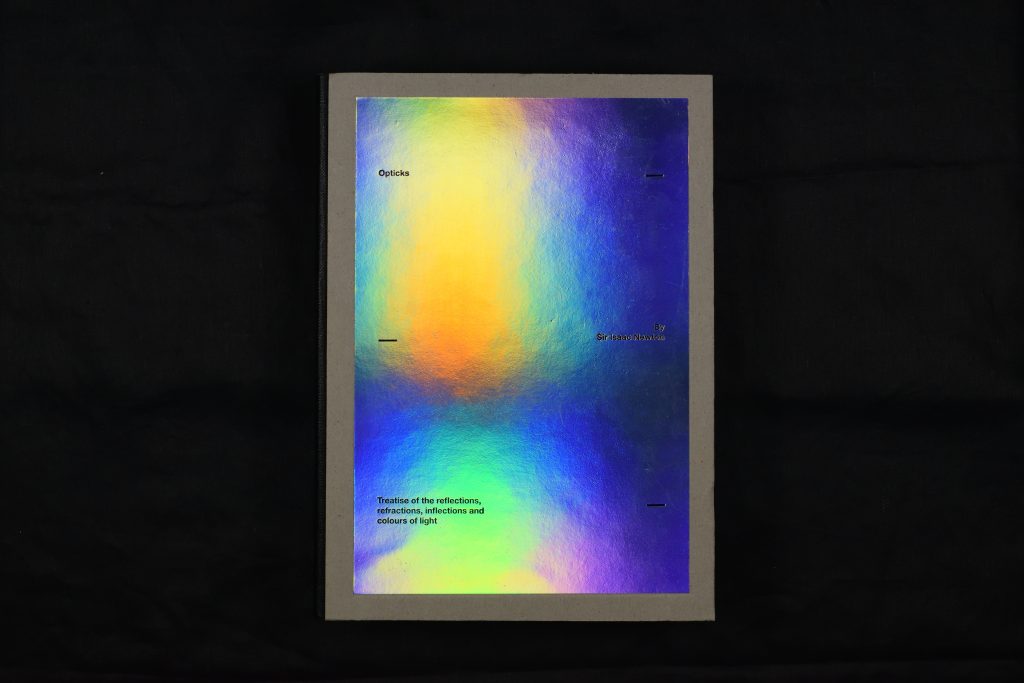
What we perceive as one thing may in reality be another. Isaac Newton (1643–1727), the natural philosopher and physician, wondered about the possibly heterogeneity of light in his undergraduate notes from 1664 known as the ‘Quaestiones quaedam’. This challenge to the longstanding view of homogeneity of light was continued in his early experiments with a glass prism, recorded in his 1666 essay, ‘Of colours’. Optics formed the subject of his first lectures of 1699, and his refracting telescope caused a scientific sensation in 1672.
In 1704, the Royal Society published Newton’s Opticks, which combined this early thinking and experiment with the cosmology and mathematics of his Philosophiæ Naturalis Principia Mathematica (1687) to present a manifesto for a new approach to describing the universe. Rather than relying on quasi-mystical accounts of ‘forces’, Newtonian science defined physical bodies in motion with mathematical precision.
The College holds a copy of the first edition of Opticks. This has recently been joined by the striking modern edition visible here.
Flatland
Abbott, Edwin Abbott. Flatland: A Romance of Many Dimensions. 6th revised ed, Oxford: Basil Blackwell, 1950. The Queen’s College.
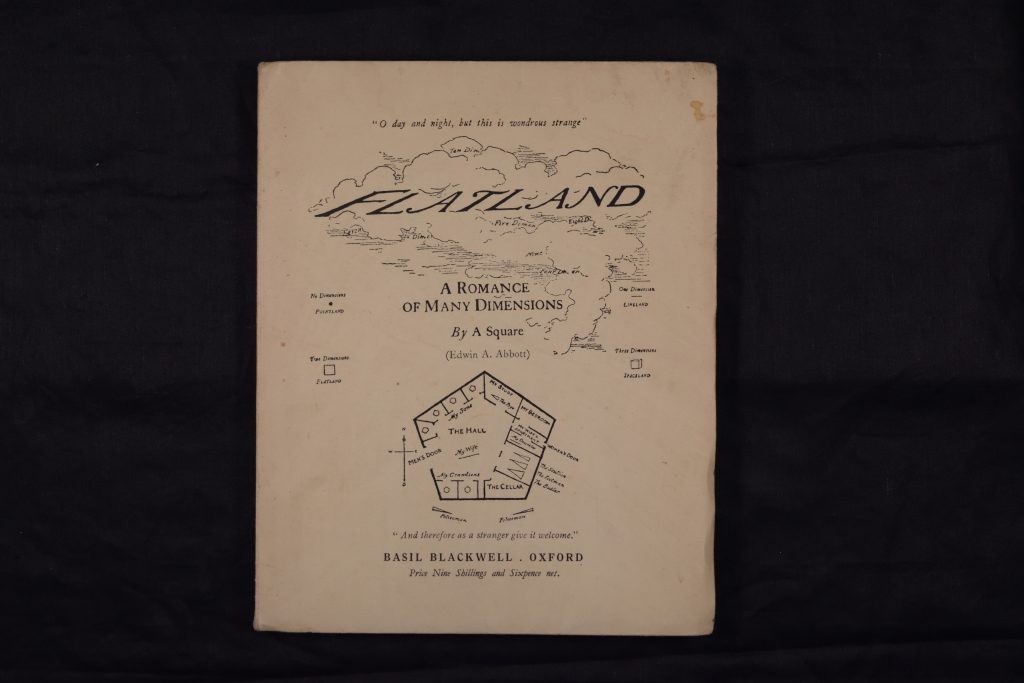
A publishing curio, as well as a mathematical puzzle, Edwin Abbott’s Flatland: a romance of many dimensions (1884) satirised Victorian society by casting women within the novella’s two-dimensional world as line segments and men as polygons of various types. Its hero the Square, dreams of one-dimensional world, a concept too challenging for the staid flat society’s perceptions. Similarly the Square is initially unable to perceive the three-dimensional visitor, the Sphere, as anything other than a disk. The Square then posits the notion of a fourth, and even more, spatial dimensions.
Rediscovered and repopularised following the publication of Albert Einstein’s general theory of relativity, Abbott’s jeu d’esprit has sparked sequels, animations, and thought experiments by Carl Sagan and Stephen Hawking. Multiple dimensions continue to puzzle and enchant mathematicians, cosmologists, and the curious alike; and, as William Garnett (1950–1932) noted in the introduction to this Blackwell edition, while some ‘mathematical minds are completely satisfied by… algebraic symbols… there are others which crave for the visualization of these results… To many…Dr Abbott’s sphere penetrating Flatland points the way to the clearest imagery of the fourth dimension to which they are likely to attain’.
‘If the doors of perception were cleansed every thing would appear to man as it is, Infinite.’
Huxley, Aldous. The Doors of Perception. London: Chatto & Windus, 1954. The Queen’s College, Vault.2024.117.
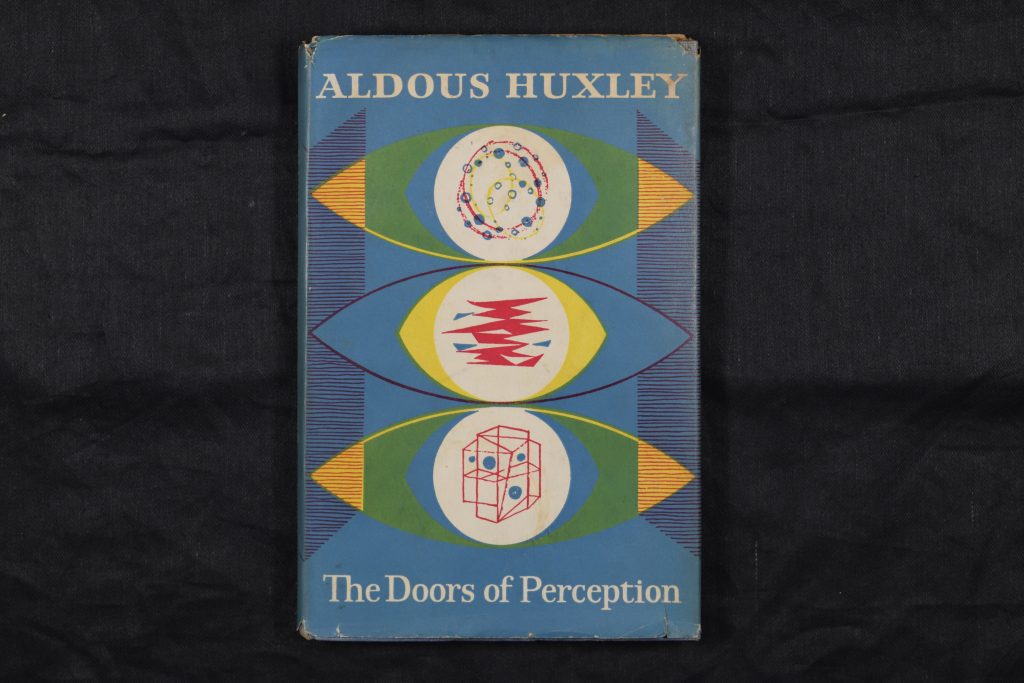
While a student at Eton, Aldous Huxley (teacher, writer, and lecturer, 1894–1964) lost his sight as a result of an untreated staphylococcic infection. He eventually regained some sight in one eye (and later some sight in both), but his work retained lifelong themes ‘of sight and insight, light and shadow, transcendent vision and human opacity’ (David King Dunaway, Oxford Dictionary of National Biography).
After the success of the dystopian novel Brave New World (1932), Huxley emigrated to the United States with plans for Hollywood scriptwriting. Suffering from depression and with a long-standing interest in the transcendent, he began to take mescaline in May 1953, briefly regaining his stereoscopic vision as well as more mordant mystical insight. Huxley offered an account of his experiences in the book shown here, which borrowed its title from William Blake’s The Marriage of Heaven and Hell (1790).
Huxley can be seen among the characters on the cover of the Beatles, Sergeant Pepper’s Lonely Hearts Club Band (1968). This counter-cultural cameo led to at least twenty three reprintings of The Doors of Perception.
The Mind’s Mistakes
Sacks, Oliver. L’Homme qui prenait sa femme pour un chapeau: et autres récits cliniques. Paris: Seuil, 1988. The Queen’s College, Rolling Shelves RC454.SA.
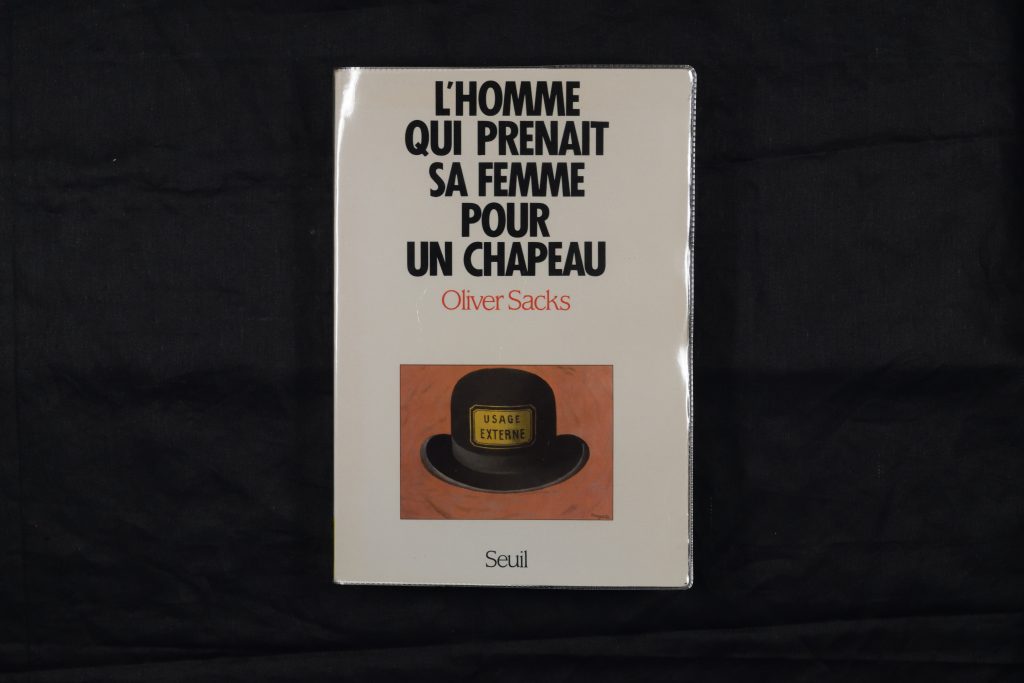
Sacks, Oliver. The Man Who Mistook His Wife for a Hat. London: Duckworth, 1985. The Queen’s College, RC454.SA.
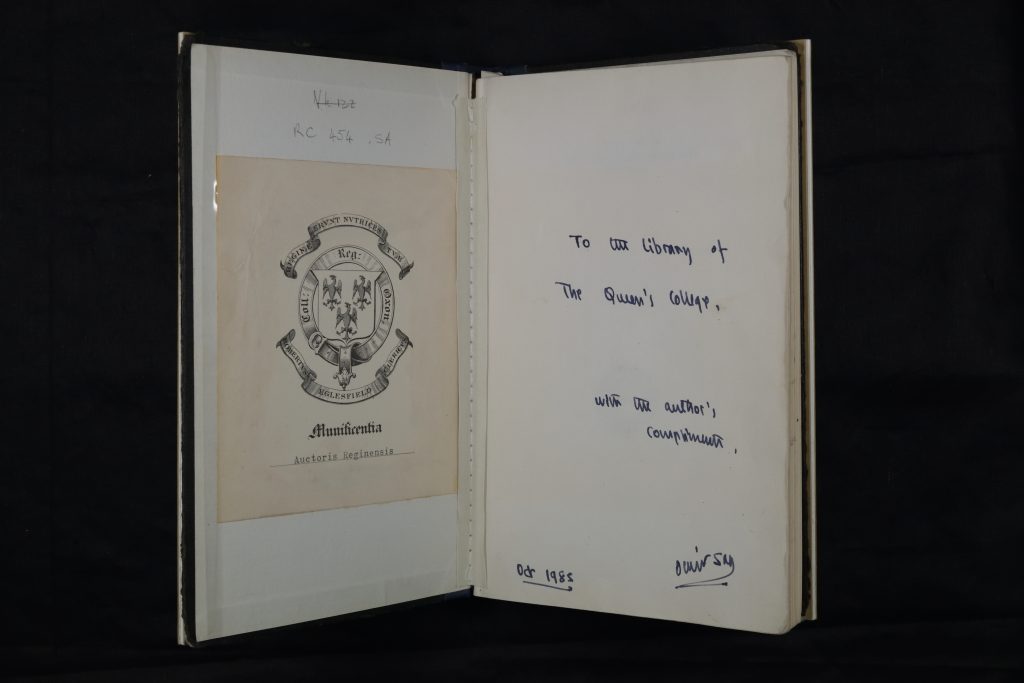
The connection between mind and brain can be a tenuous one, and one that can be complicated by physical or psychological injury. In contrast to the sensationalism drawn on by Jeremy Bentham, modern physiology and psychological science stress the extent to which the mind mediates the signals received from our five senses.
Oliver Sacks (1933–2015) studied at the College in the 1950s before moving to work as a neurologist in the United States. Here, he worked with a group of survivors of sleeping sickness, recording his experiences in his book, Awakenings (the basis of the 1990 Oscar-winning motion picture). Sacks’ other popular science writings included case studies of people with neurological disorders, including The Man Who Mistook His Wife for a Hat and Other Clinical Tales (1985; also produced as an opera in 1986) which is especially concerned with phenomenological manifestations and disturbed perceptions.
Seeing comes before words
[A Book made by John Berger, et al]. Ways of Seeing: based on the BBC television series with John Berger. London: BBC Books & Penguin, 1972. The Queen’s College N7430.5.BE.
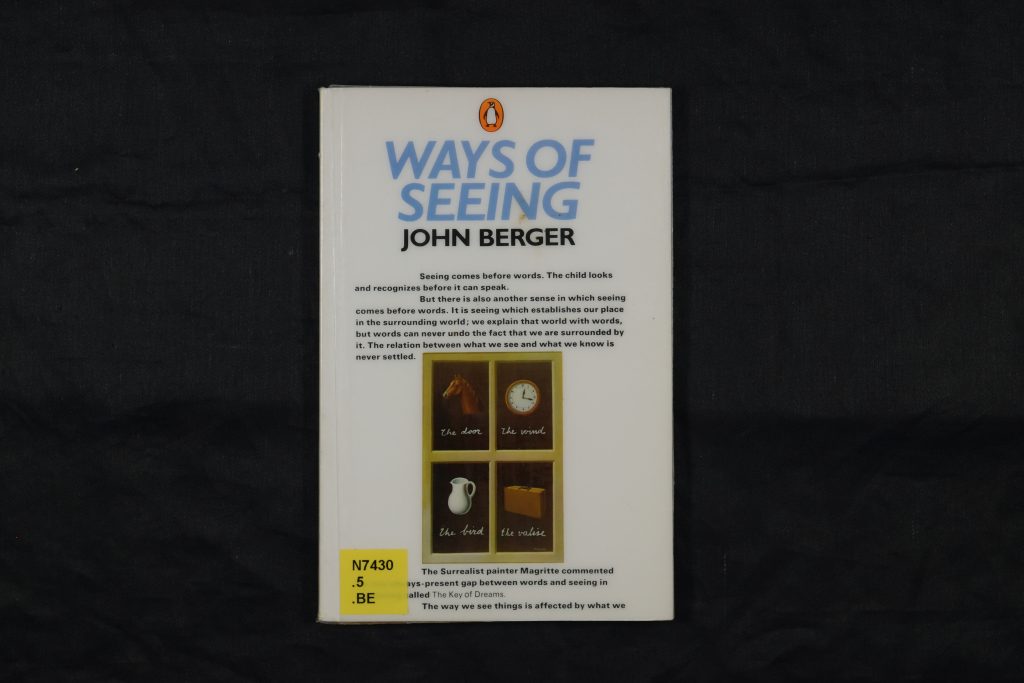
Perception is shaped by context and comparison. In 1970, the critic John Berger (1929–2017) presented a seven-part BBC1 television series, ‘Ways of Seeing’. Taking a view that ‘the relation between what we see and what we know is never settled’, Berger shows how where and how we see images can be as crucial as the image itself. The episodes explore the representation of women, art as property, the reproduction of images, and the language of advertising, informing several decades of art and communications theory.
The subsequent book (1972), which remains in print, was designed by Richard Hollis, who played with the usual form of a paperback, starting the essay’s text on the cover. It contains a host of images not in the TV series, and makes use of a heavy, sans serif font. The collage effect is to give the images the same weight as the illustrations, making the images perform as text. Many of the images come from Hollis’s wife, the cartoonist and illustrator Posy Simmonds.
One of Berger’s last books, Cataract (2012), was an essay in the spirit of Montaigne, recording the effects of a cataract operation on his eyes.
‘The Primary of Perceptions’
Merleau-Ponty, Maurice. Phénoménologie de la perception. 4th ed., Paris: Librarie Gallimard, 1945. The Queen’s College.
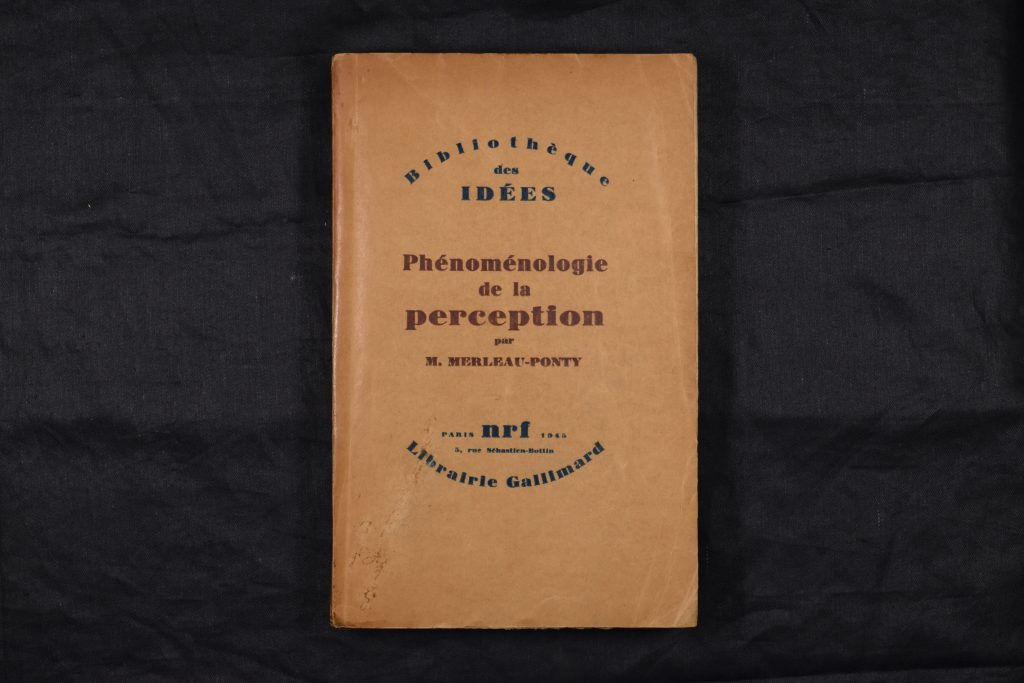
Phenomenology is the philosophical study of the relationship between appearance and reality, and explores how perception mediates (or constitutes) the world. Such questions have a long history, but ‘phenomenology’ as an influential philosophical movement was begun by Edmund Husserl (1859-1938) at the beginning of the last century. He sought to provide a scientific basis for the existence of the world, developing a detailed, description and analysis of conscious experiences. It was approach taken up by Martin Heidegger (1889-1976) and Jean-Paul Sartre (1905-1980), who in contrast to Husserl’s ‘intentional consciousness’ saw ‘being-in-the-world’ and existence as foundational concepts.
Maurice Merleau-Ponty (1908-1961) returned the body to this debate. In 1945, he published the bestselling Phénoménologie de la perception, in which he argued that our lived body is an integral part of our being and perception. In contrast to the mind/body duality imposed by Descartes, our body’s actions in the world and its interaction with memories and thought affect our perceptual experience — the fundamental way that we engage and understand the world. It is an approach that influenced many other disciplines, from neuroscience to studies of computer user interfaces.
Curated by Dr Matthew Shaw, College Librarian
Explore more of our exhibitions
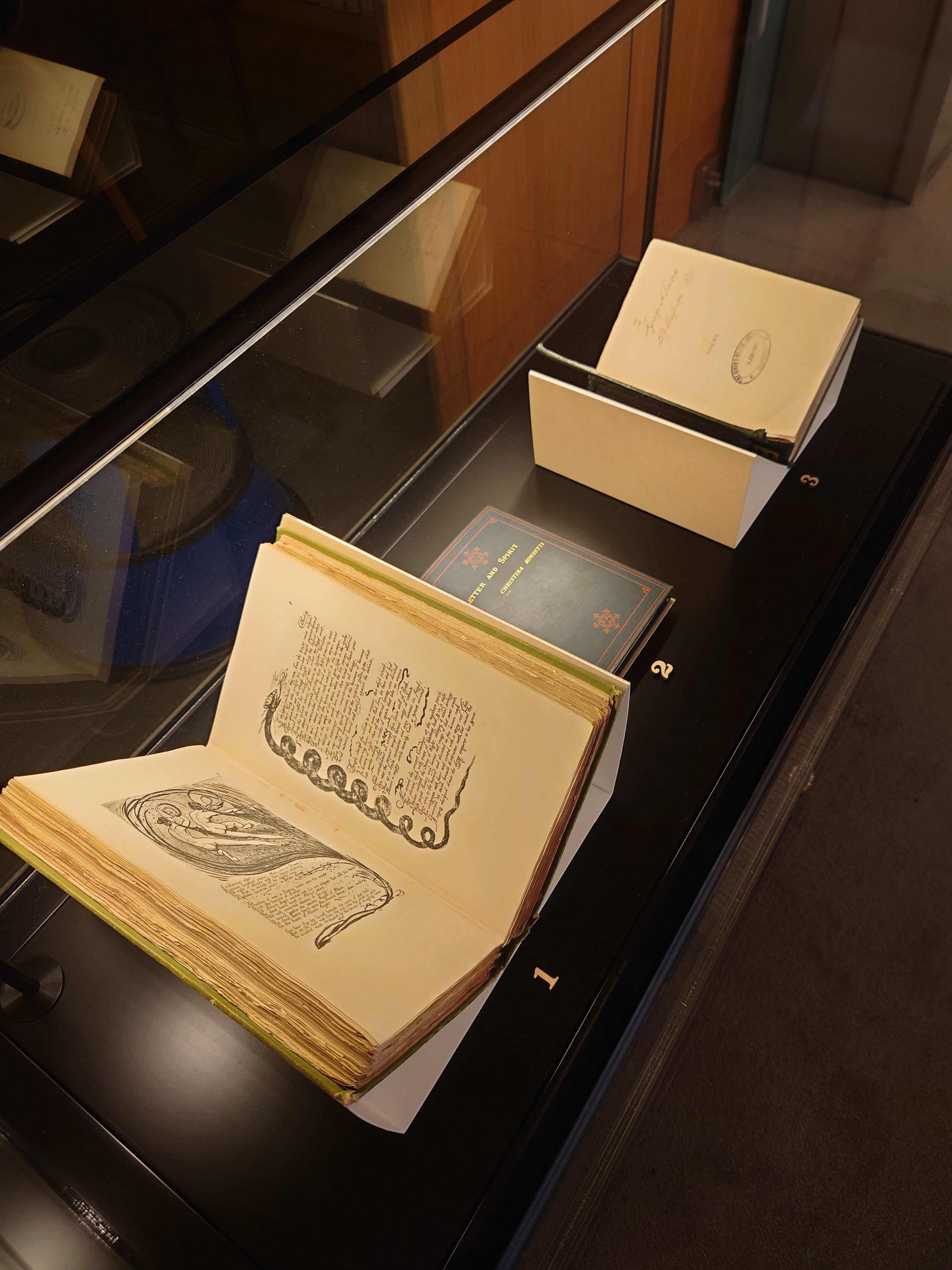
‘From the author’
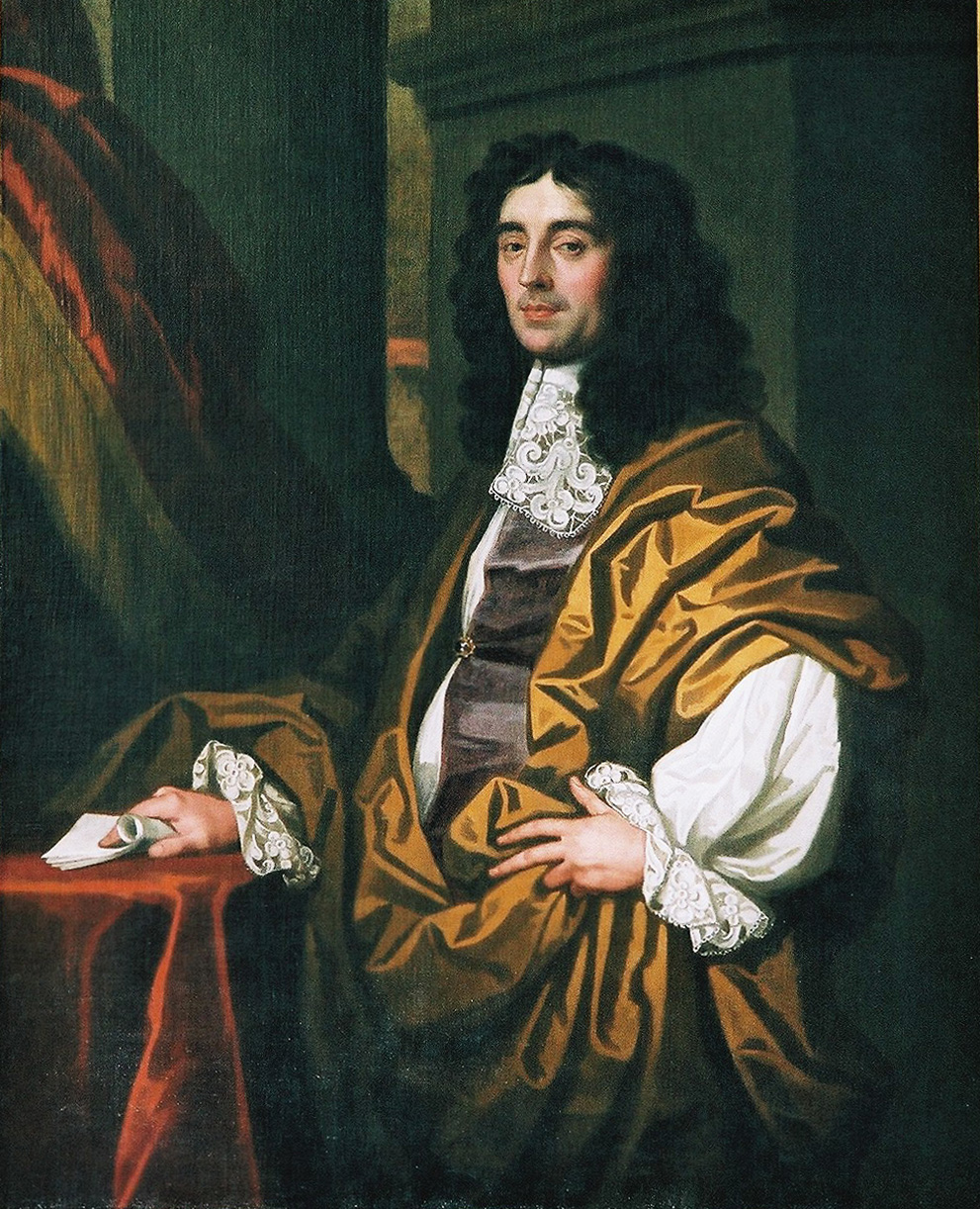
Joseph Williamson and the establishment of the transatlantic slave trade
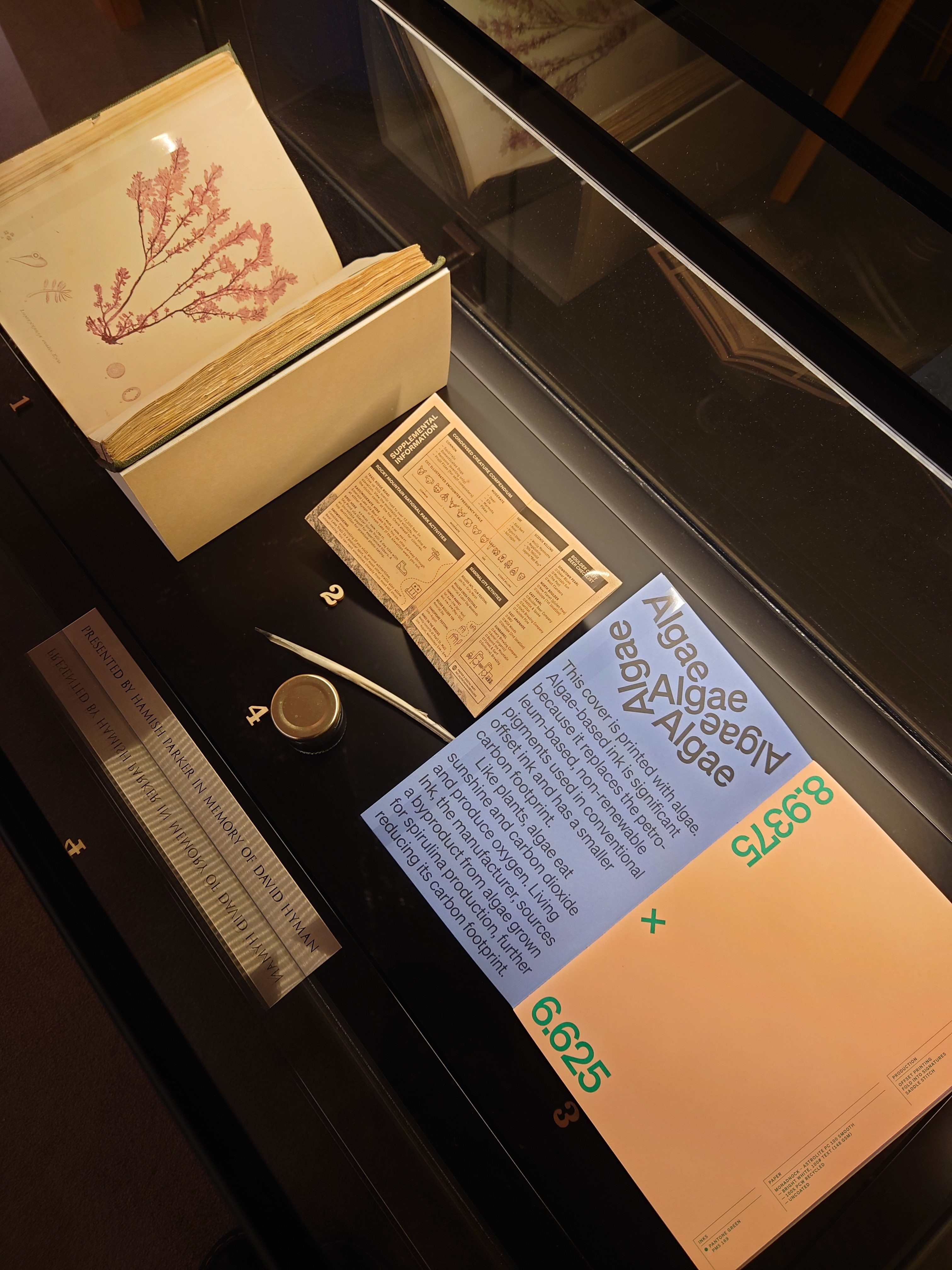
Ink : an exhibition
